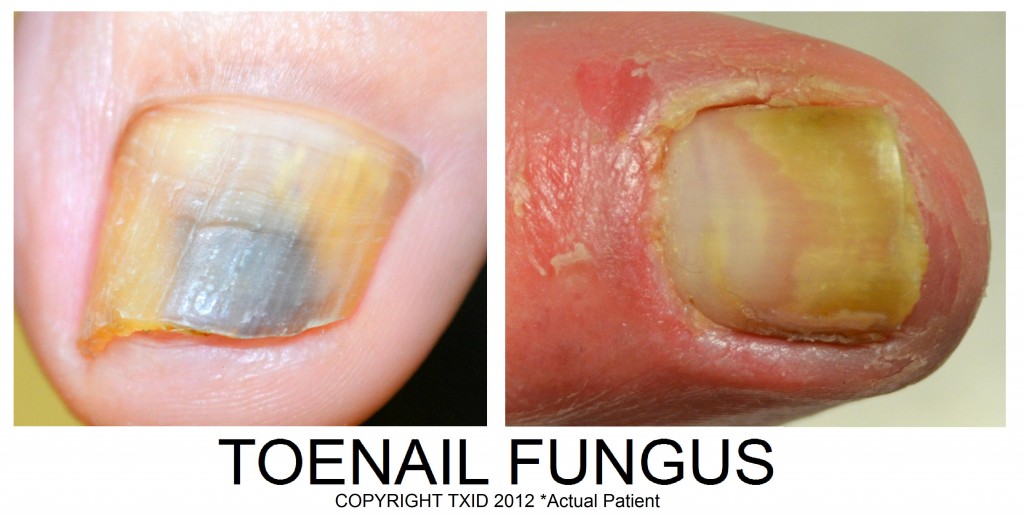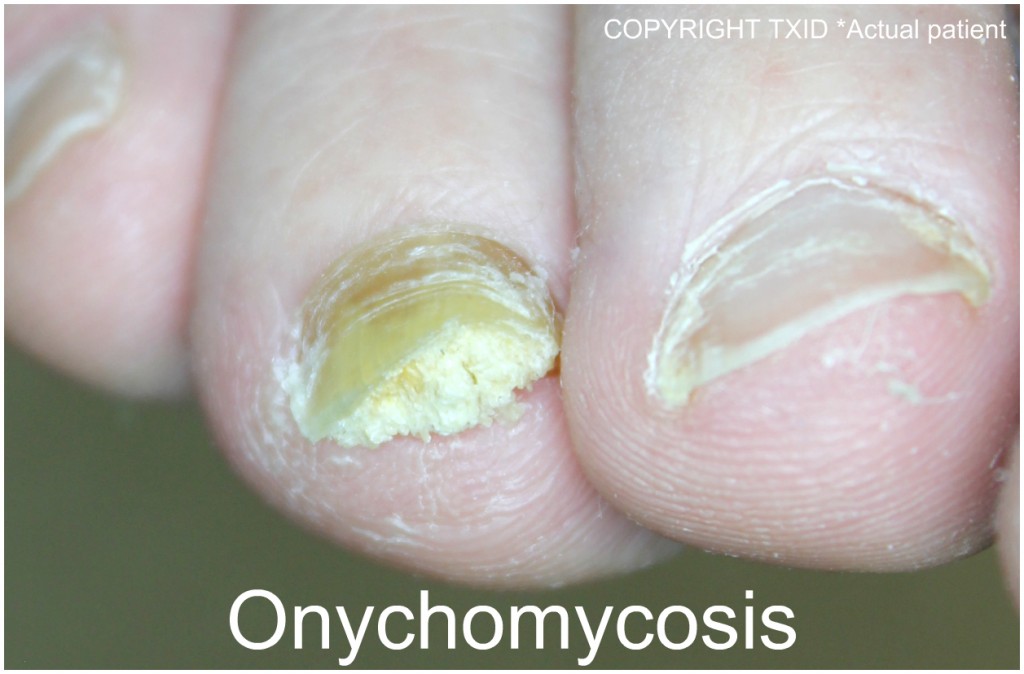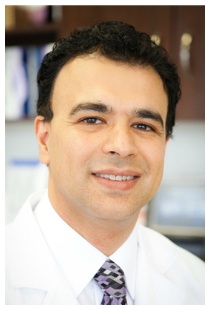Laser Treatment of Nail Fungus (Onychomycosis)
Texas Institute of Dermatology, San Antonio Nail Clinic offers that latest technology in laser treatment of nail fungus. This treatment is FDA approved and clinically proven to be effective in the treatment of nail fungus. 
What is nail fungus (Onychomycosis)?
Nail fungus, or Onychomycosis, is a fungal infection in one or more of your nails. Typically, the early signs of nail fungus are yellow or white spots under the distal (outermost) part of nails. These white spots represent sub-ungal hyperkeratosis. If left untreated, these spots begin to spread throughout the entire nail, and nail will become separated from the nail bed (onycholysis), or discolored, wrinkled and thickened. Nail Fungus occurs more often in toenails than fingernails. Not only is toe nail fungus unsightly, but it may be quite painful in case of severe fungal involvement (rare).
These fungal infections are a result of fungi growing in and under the nails. In general, the fungi will enter through a small cut or a separation between the nail and the nail bed or after a pedicure. Then, if conditions are right (warm and moist), the fungus will continue to spread throughout the nail. Patients with Diabetes, or those who wear boots in warm and humid weather are more prone to nail fungus. Some patients with HIV develop fungus in finger nails; superficial nail discoloration could be an early sign of HIV.
What are the signs and symptoms?
 Some of the early signs of nail fungus include:
Some of the early signs of nail fungus include:
- Thickened nails
- Crumbly nails
- Brittle nails
- Ragged edges
- Distorted color and texture
- Dull and/or dark yellow in color
- Loosening and/or separation of nail from nail bed
If you feel like any of these symptoms apply to you, please do not hesitate to contact our office to schedule an appointment at (210) 698-6777 or [email protected].
What are my treatment options for nail fungus?
Nail fungus can often be difficult to treat and is prone to relapses. Multiple treatments are necessary in order to achieve desired results for nail fungus. Many over-the-counter medications for treatment of toenail fungal infections are available. However, most, if not all are ineffective, especially in severe cases.
Treatment options for Nail Fungus include:
- Topical Penlac Medication – Most topical medications aren’t as effective as other treatment options and are rarely prescribed by themselves. Some doctors will prescribe topical medications in combination with oral medications. The only FDA approved topical medication is a nail lacquer known as Penlac. Daily use of Penlac treatment for a year’s time has shown some improvement in treating a few nail fungus conditions.
- Nail Surgery – in more severe cases, surgical removal of the nail may be necessary in additional to oral or laser treatment. A new nail will grow back and, if proper post-surgical guidelines are followed in additional to oral or laser treatment, the probability of the infected nail growing back is significantly reduced. However, no assurance can be made that the fungus will not return at a later date.
- Oral Medication – this is the most widely used treatment option for nail fungus. Research studies have shown terbinafine (Lamisil) and intraconazole (Sporanox) to be the most the most effective oral medication to fungal infections in the nails. These medications promote new, healthy nail growth that will eventually replace the infected nail. These treatments usually last 6-12 weeks, but the full result of treatment may not be realized for several months after treatment has finished. While on these medications, routine blood tests are necessary to monitor the liver function. Alcohol should be avoided while using these medications.
- Laser Treatment of Nail Fungus– this FDA approved treatment option is becoming more and more popular as laser technology and research continues to grow. At San Antonio Nail clinic of Texas Institute of Dermatology, we offer a revolutionary laser for treatment of nail fungus. The state-of-the-art Nd:YAG laser creates micro-cavitations and acoustic shock waves on the surface of the nail. The waves, transmitted to the nail bed, produce heat and irritates the fungal colony. This process may decapsulate the fungus spores. Additionally, as the fungus absorbs the laser light, it builds up heat and ultimately deactivates the unwanted microorganism. The laser light also helps to treat embarrassing yellow and brown streaks in the nail. The color changes are, however, happening over a long period of time.
Which treatment option is best for me?
Treatment options for nail fungus vary depending on the severity and type of infection. In most cases Dr. Ghohestani recommends a combination therapy approach. He believes the best treatment option focuses on attacking the fungus from both the inside (using Lamisil oral medication) and out (using the Nd:YAG laser technology). This combination therapy allows us to attack the fungus on multiple levels leading to improved outcomes for our patients. Contact us at (210) 698-6777 and/or [email protected] to schedule an appointment with our renowned dermatologist.
How can I prevent Toe Nail Fungus?
To prevent toe nail fungus recurrence, Dr. Ghohestani recommends:
– Avoid boots when you are in hot and humid weather
– Air your feet out frequently during the day
– Avoid old shoes
– Anti-fungal spray for feet and shoes
– Avoid pedicures
– Keep feet clean and dry
– Change socks daily
******
Why choose the Texas Institute of Dermatology for your nail fungus treatments?
Our mission is to serve as a leading center for understanding and treating skin, hair, and nail diseases in South Texas through excellence in patient care, research, and education. We want you to feel that you have been treated with the comfort, privacy, safety, and satisfaction that you deserve. This is why all of our procedures are performed or supervised by our renowned dermatologist, Dr. Reza Ghohestani. His experience, combined with the latest technology and a caring staff, is why the Institute is consistently ranked among the top dermatology centers in San Antonio and Boerne areas based on satisfaction surveys. We currently serve communities throughout Bexar and Kendall counties, including San Antonio, Boerne, Leon Springs, Fair Oaks Rank, Canyon Lake City, etc. Many of our patients also come from San Marcos, New Braunfels, Kerrville, Austin, Wimberly, and Corpus Christi.
* If the Content contained on this site contains medical or health sciences information, it is intended for answering some common skin care questions. No suggested test or procedure should be carried out without visiting a health care professional and unless, in the reader’s judgment, its risk is justified. Because of rapid advances in the medical sciences, we recommend that the independent verification of diagnoses and drug dosages should be made. NEITHER TEXAS DERMATOLOGY INSTITUTE NOR ANY OF ITS AFFILIATES OR LICENSORS SHALL BE LIABLE TO YOU OR ANYONE ELSE FOR ANY LOSS OR INJURY, CAUSED IN WHOLE OR PART BY ITS NEGLIGENCE OR CONTINGENCIES BEYOND ITS CONTROL IN PROCURING, COMPILING, INTERPRETING, REPORTING OR DELIVERING INFORMATION THROUGH THE SITE. IN NO EVENT WILL TEXAS DERMATOLOGY INSTITUTE, ITS AFFILIATES OR LICENSORS BE LIABLE TO YOU OR ANYONE ELSE FOR ANY DECISION MADE OR ACTION TAKEN BY YOU IN RELIANCE ON SUCH INFORMATION. TEXAS DERMATOLOGY INSTITUTE AND ITS AFFILIATES AND LICENSORS SHALL NOT BE LIABLE TO YOU OR ANYONE ELSE FOR ANY DAMAGES (INCLUDING, WITHOUT LIMITATION, CONSEQUENTIAL, SPECIAL, INCIDENTAL, INDIRECT, OR SIMILAR DAMAGES) EVEN IF ADVISED OF THE POSSIBILITY OF SUCH DAMAGES.You hereby agree to indemnify, defend and hold Texas Dermatology Institute, its directors, officers, shareholders, parents, subsidiaries, affiliates, agents and licensors harmless from and against any and all liability, losses, damages and costs, including, without limitation, reasonable attorneys’ fees, arising from your use of the Site or Content.






